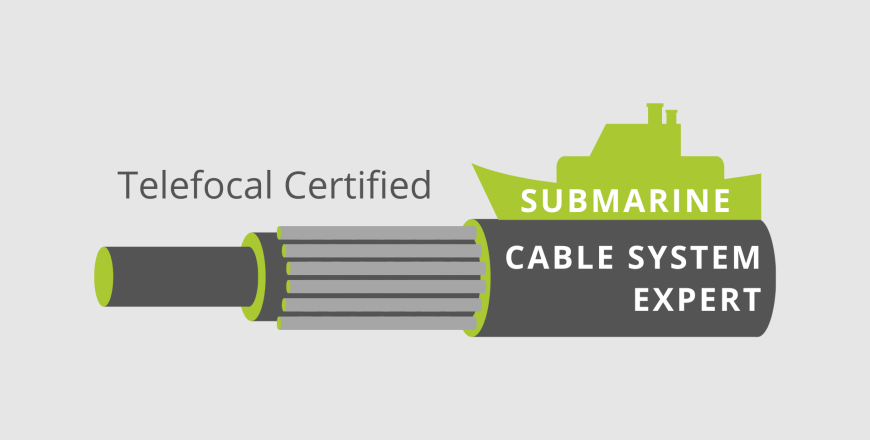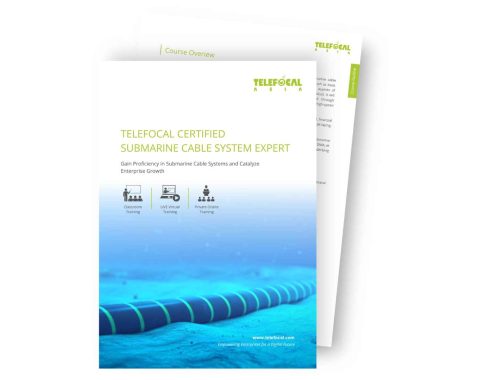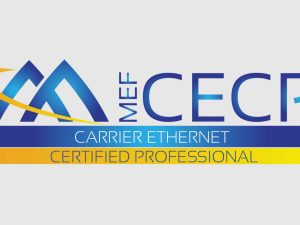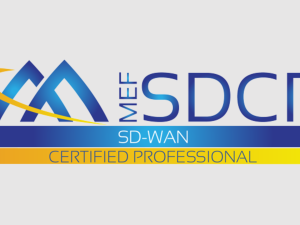Telefocal Certified Submarine Cable System Expert (TC-SCSE)

Course Overview
In this 5-day certification course, participants will gain a comprehensive understanding of submarine cable system networks, covering both technical and commercial perspectives. Submarine cable systems serve as the backbone of global internet connectivity, supporting international data traffic and enabling high-speed, reliable communications across continents. As the demand for high-capacity, low-latency connectivity continues to grow, the planning, development, construction, and operations of submarine cable systems have become more complex, requiring expertise in both engineering design and business strategy.
This course provides in-depth coverage of key submarine cable system components, including wet and dry plant infrastructure, Branching Units (BU) for multi-destination connectivity, and essential equipment like Submarine Line Terminating Equipment (SLTE), Power Feed Equipment (PFE), and Optical Add-Drop Multiplexing (OADM) architectures. Participants will also learn about optical transmission technologies used in modern open submarine cable networks, including Dense Wavelength Division Multiplexing (DWDM), Optical Transport Networks (OTN), and Carrier Ethernet.
The course delves into the engineering aspects of submarine network design, including fiber optic technologies such as ITU-T G.654 (cutting-edge ultra-low-loss fibers) and ITU-T G.979 (characteristics of monitoring systems) and ITU-T G.977.1 (open cables). Participants will explore critical system performance optimization tools such as ROADMs, ensuring flexible signal transmission across long-haul subsea networks.
Additionally, the course covers submarine cable project lifecycle stages, from proposal development and financial viability assessment to route planning, route survey, cable construction agreements, permits and licenses for cable laying, and wet plant maintenance agreements in different marine zones. Through industry case studies, participants will understand how submarine cable businesses are structured—whether through Consortium models, Private-Public Partnerships (PPP), or privately owned submarine networks—to support the evolving needs of global telecommunications and cloud service providers.
From a commercial standpoint, the course will provide insights into how submarine cable bandwidth (e.g., MAU/MIU allocation) is monetized through services such as IP transit, peering, International Private Leased Circuits (IPLC), and Dedicated Wavelength Agreements (DWA). Participants will also explore the role of Open Submarine Cable networks in fostering competition and enabling carrier-neutral interconnectivity for global internet traffic.
By the end of this certification program, participants will have a solid foundation in submarine cable systems, equipping them with the necessary knowledge to design, operate, and manage subsea networks in an increasingly interconnected world.
Target Audience
This course is designed for telecommunications professionals, engineers, project managers, and technical personnel involved in the design, planning, implementation, and maintenance of submarine cable systems.
Key Benefits
Participants will acquire practical skills for managing submarine cable projects and will be equipped with the knowledge and tools necessary to succeed in their roles.
Duration & Training Format
- Classroom: 5 days
- LIVE Virtual: 35 hours
*Note:
- A minimum of 8 or more participants is required for a Classroom session to commence.
- A minimum of 6 or more participants is required for a LIVE Virtual session to commence.
- LIVE Virtual courses can be conducted for 5 hours or 7 hours daily. Please note that the number of training days will be extended if you opt for 5 hours daily.
Upcoming Course Dates
- 14 – 18 Jul 2025 (Mon – Fri), GMT +8
- 15 – 19 Sep 2025 (Mon – Fri), GMT +8
If you are keen on attending any of the scheduled courses, please register your interest via our course enquiry form.
Course Objectives
At the end of this course, participants will be able to:
- Understand the principles of optical communications, including its limitations and advantages
- Evaluate the suitability of submarine cables compared to other communication options
- Analyze different financing models for submarine cable systems and determine the most appropriate choice
- Identify the components of a submarine cable network, such as the dry plant and wet plant
- Explain the functionality of key components like the SLTE, PFE, C-OTDR, BUs, repeaters, and gain equalizers
- Differentiate between types of submarine cables used at various depths and environments
- Describe the processes involved in laying submarine cables, tracing faults, repairing damages, and the tools used in these activities
- Understand how and why the wet plant is powered using a single conductor
- Recognize the significance of the beach manhole and its earthing/grounding requirements
- Detail the activities involved in conducting a route survey
- Understand the consortium structure and their role within such a framework
- Participate effectively in committees and meetings related to consortium cables and apply best practices
- Manage the ownership and maintenance of submarine systems
- Explore the optical systems used in submarine cables and potential commercial products available
- Appreciate the role of international regulations and organizations (eg. UNCLOS, ICPC)
- Analyze real-world case studies to understand practical challenges and solutions in submarine cable system projects
Course Outline
- Submarine Cable Systems Overview
- Introduction and Interesting Facts about Submarine Cables
- Submarine Cable History: Telegraph to Coaxial to Fiber Optics Submarine Cable
- Repeatered vs Unrepeatered Systems
- Cable Laying Tools: Customized Ship, Grapnel, Plough, ROV, etc.
- Festoons
- Submarine Cable Examples: APAC, Atlantic, Pacific, Arctic, etc.
- Project Terminology: RFS, EOS, Estimated Cost, Landing Points, Total Length, System Supplier, Owners, etc.
- Project Phases: Engineering, Survey, Manufacturing, Installation, Commissioning
- Technical Terminology: Design Capacity, Lit Capacity, Purchased Capacity, Number of Wavelengths per Fiber Pair, Capacity per wavelength
- Statistics: Planned Systems, Major Suppliers, Major Surveyors, Cable Faults, Repair Times
- Submarine Cable Technologies
- Optical Fiber and its Components
- Optical Spectrum: Attenuation vs Wavelength
- Limiting Factors in Optical Fibers: Attenuation, Dispersion, OSNR, Non-Linear Effects
- ITU Standards for Optical Fiber
- Optical Power Budget
- Client Traffic: Legacy vs Modern
- WDM: CWDM vs DWDM
- ITU Grid and Channel Spacing
- Components in DWDM Network: Mux/Demux, Optical Amplifier, Optical Transponder, OADM, ROADM, etc.
- Working of Optical Amplifier: EDFA vs RAMAN
- Ethernet Over DWDM
- Key Technologies for Improving Transmission Capacities
- Multicore Fiber
- Repeater Pump Farming
- Submarine Cable Network
- Unique Differences between Submarine Network and Terrestrial Networks
- Components of SMC Networks: Dry Plant Vs Wet Plant
- Cable Landing Station
- SLTE (Submarine Line Terminal Equipment)
- PFE (Power Feeding Equipment)
- Beach Manhole
- Subsea Cable: Composite vs Regular (Unrepeatered)
- Wet Plant: Subsea Cable, Repeaters, Branching Units, Gain Equalizers
- Network Architecture (P2P, Festoon, Ring, Trunk and Branch, OADM, Hybrid)
- Backhaul Vs Fronthaul
- Transoceanic and Coastal Networks
- Repeatered and Repeaterless System
- Cable Landing Station (Site Selection, Space and Construction Standards)
- Connecting Terrestrial Network to SMC Network (PoP2PoP Connectivity, Traditional Model, Flexible Models, Open SLTE, Open CLS, Open Cable)
- Dispersion Compensation and OSNR
- Exercise: Traffic Matrix
- Laws of Seas and Protection of Cables
- International Laws
- UNCLOS (UN Convention on the Law of Seas)
- Major Boundaries Defined in UNCLOS: Internal Waters, Territorial Waters, Archipelagic Waters, Exclusive Economic Zone (EEZ), High Seas
- Rights and Responsibilities Regarding Laying of Subsea Cables in different parts of Sea
- Conflicting Boundaries
- ICPC (International Cable Protection Committee) and its Role
- Clauses of the Law related to Submarine Cables
- Submarine Cable Construction
- Subsea Cable Manufacturing
- Recommendations for Cable Types for Different Environments/Depths
- Rock Armored, Double Armored, Single Armored, Deep Water Cables
- Jointing and Coupling (UJ, UC, UQJ)
- Power Feed Design
- ITU Fiber Standards: G.652, G.653, G.654, G.655, G.656, G.657
- Examples of Subsea Cables and their Layers
- Submarine Cable Project Life Cycle: Planning and Development
- Submarine Cable Ecosystem
- Stakeholder Management
- Project Milestones
Phrase 1 – Planning
- Investment Business Model
- Market Demand
- Risk Analysis
- Ownership Model
- Partnerships
Phase 2 – Project Development
- Construction and Maintenance Agreements
- Landing Party Agreements
- Competitive Procurement
- RFQ Development
- Bid Receipt
- Adjudication
- Selection and Award
- Desk Top Study
- Permitting
- Final Route Selection
- Cable Route Surveys
- Route Position List (RPL) and Straight Line Diagram (SLD)
- Cable and Equipment Selection
- Procurement
- Responsibility Matrix
- Submarine Cable Project Life Cycle: Construction and Operations
Phase 3 – Construction
- Cable Laying Ship and Marine Tools: Grapnel, Plough, ROV
- Purchaser Responsibilities
- Project Risks
- Permits
- Submarine Cable Loading
- Pre-Lay Grapnel Run
- Cable Burying with Plow
- Cable Inspection and Maintenance: ROV
- Dry Plant Construction: CLS and Equipment
Phase 4 – Operations
- Operations Administration and Management
- Marine Operations
- Cable Repairs: Vessel Operations, Fault Locating, Cable Recovery, Cable Jointing
- Fault Localization Techniques
- Repair Scenarios and Typical Timelines
- Marine Maintenance Zones
- Open Cables and Monitoring
- Open Cables Defined
- Open Cable CLS
- Challenges of Open Cables
- ITU G.979 (Characteristics of Monitoring Systems for Submarine Cables)
- General Architecture of Repeaterless System
- Monitoring Output from TTE (Terminal Transmission Equipment)
- Characteristics of Monitoring Equipment
- Fault Location
- Recommended Parameters for Monitoring
- OTDR (Optical Time Domain Reflectometer)
- Coherent OTDR (C-OTDR)
- Subsea Cable Financing and Ownership Models
- Project Partners
- Private Ownership, Consortium and PPP (Public-Private Partnerships)
- Pros and Cons of each Ownership Model
- Cable OPEX
- Minimum Investment Unit (MIU)
- Stakeholder Classification and Analysis
- Examples of Private and Consortium Models
- Examples of MIU
- Half Circuits
- Financial Feasibility: Payback Period, Net Present Value and Internal Rate of Return
- Presales and IRU (Indefeasible Right of Use)
- Case Study: Tonga-Fiji Submarine Cable
- Project Highlights
- Tonga Broadband Growth
- Financing and MOU Signing
- Project Savings: Tonga Domestic Cable
- Conclusions
- Case Study: Sothern Cross Cable
- Project Highlights
- Landing Points
- Capacity Expansions
- Damage Incidents
- Southern Cross Next
- Southern Cross Cable Products
- Ring Configuration and Drop Capacities
- Purchase Options: IRU and Lease
- Case Study: Kumul Submarine Cable Network Project
- Financing for the Cable
- Role of INA, BRI and NICTA
- Submarine Cables: Kumul, Coral Sea and PIPE
- Project Details
- Conclusions and Discussion
Certification: At the end of the course, participants will sit through a proctored online examination. The TC-SCSE professional certificate will only be issued upon:
- Scoring 60% or higher in the written exam AND
- Achieving at least 75% attendance for the course.
Pre-requisites
A background in a telco business and knowledge on optical networks would be beneficial.
What is so special about Telefocal's Submarine Cable Systems Certification programme?
With years of experience in the field, Telefocal is a leader in providing training and development solutions to organizations and IT/Telecom professionals worldwide. Our team of highly qualified and experienced trainers who are experts in the field of Submarine Cable System deliver highly effective interactive, and practical training, with a focus on real-world scenarios and case studies.
Our course materials are developed based on years of practical design and implementation experiences by our Submarine Cable Systems experts, and updated in tandem with new Submarine Cable Systems technology and business developments.
Testimonials


Get Your Official Course Brochure
Download the official course brochure for a detailed overview, including key learning outcomes, training benefits, and testimonials. This brochure is designed for easy submission to management for approval and budget considerations.

Ready to Take the Next Step?
Start your learning journey and advance your expertise! Submit a course enquiry today, and our team will get back to you within 24 hours with all the details you need to enroll.


